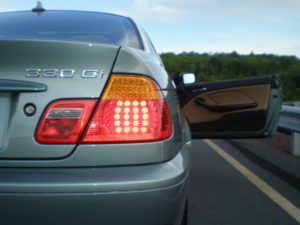Rear-End Car Accidents and Modern Vehicle Requirements

Until about 30 years ago, automobiles were not required to have “high-mounted brake lamps, or third brake lights,” according to a recent article in the Chicago Tribune. Beginning in 1986, a federal mandate required that all new vehicles be equipped with these safety lights “to significantly slash the number of rear-end collisions and injuries.” How would these third brake lights better prevent rear-end collisions? The article suggests that federal regulators believed the presence of these brake lamps would make it easier for following drivers—those driving behind the vehicle—to notice when the car in front of them was slowing down.
However, 30 years later, rear-end auto accidents are still a significant problem in Chicago and throughout the U.S. To be sure, “rear-end collisions remain one of the most common types of car crashes, accounting for more than 40 percent of all incidents on U.S. roads.” What else can federal mandates for auto safety teach us about car accident prevention? And how can we do better to prevent rear-end collisions with new automotive technology?
Making Assumptions About Brake Requirements and Accident Prevention
When the mandate for third brake lights came about, auto manufacturers saw this as a relatively inexpensive way to prevent auto accidents. Indeed, the National Highway Traffic Safety (NHTSA) expected high-mounted brake lamps on new vehicle to result in a drastic reduction of auto accidents. Within one year, the NHTSA predicted that 900,000 fewer crashes would occur annually, which would lead to a reduction in auto accident injuries by 40,000. Due to the expected drop in traffic collisions, the NHTSA estimated that the costs associated with car crashes would be reduced by around $434 million.
To be clear, third brake lights would not have been able to do too much to prevent a high-speed car accident. If a driver is speeding and has failed to leave sufficient following room, that driver might not be able to stop the vehicle in time to avoid a rear-end collision, even if that driver sees that the car ahead is braking. However, third brake lights could, in theory, “prevent relatively low-speed accidents that typically don’t result in death or severe injuries.”
Will Crash-Avoidance Systems Make an Impact in Reducing Car Accidents?
It is not clear whether third brake lights have had any noticeable impact on the rate of rear-end collisions over the last three decades. As the article points out, in the years between 1988 and 2014, fatal rear-end crashes actually increased by almost one percent. Non-fatal rear-end collisions that caused injuries also rose by about four percent in that same time period, while the number of total rear-end crashes—including those that only resulted in property damage—climbed by five percent. However, given that the total number of cars on the road also increased during those years, it is possible that the numbers do not tell the whole story. To be sure, “the consensus seems to be that the third-light mandate worked,” the article reports.
Whether we think the requirement of third brake lights has had an effect or not, it is important to consider whether new technologies can help to prevent serious and fatal auto accidents. As the article points out, one of the most recent innovations aimed at lowering the rate of rear-end collisions is crash-avoidance technologies that include forward collision warning systems and automatic brakes. Similar to the high-mounted brake lamps, experts anticipate that these systems will yield a lower number of rear-end collisions each year. For now, we will have to wait and see.
In the meantime, if you or someone you love got hurt in a traffic collision in Chicago, an experienced Chicago car accident lawyer can assist with your case. Contact Woodruff Johnson & Evans Law Offices to discuss your options.
